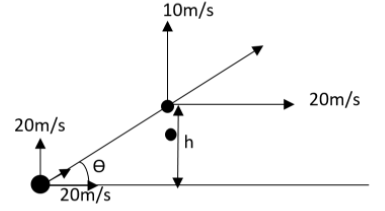Question
Question: Let us assume that a particle of mass \(2m\) is being projected at an angle of \[45{}^\circ \] with ...
Let us assume that a particle of mass 2m is being projected at an angle of 45∘ with horizontal velocity of 202ms−1. After 1s, an explosion takes place and the particle is cracked into two equal pieces. Because of the explosion one part will come to rest. What will be the maximum height reached by the other part. Take g=10ms−2,
& A.50m \\\ & B.25m \\\ & C.40m \\\ & D.35m \\\ \end{aligned}$$Solution
Find the height moved by the particle in one second. Find the velocity of the particle after one second and the angle with the horizontal is to be calculated. The initial and final velocities of the particle is to be found. And the final height will be found by the equation of maximum height. Total height will be the sum of both the heights.
Complete step by step solution:

The height moved by the particle in 1scan be found by the equation,
h=ut+21gt2
As mentioned in the question,
The initial velocity can be shown as,
u=20ms−1
The time taken will be written as,
t=1s
And the acceleration due to gravity will be,
g=10ms−2
Substituting the values in it will give,
h=20×1+21×10×12=15m
After one second, the vertical speed will become v. Let us perform newton’s first equation of motion.
That is,
v−u=−gt
Substituting the values in it,
